At STH, we have the most comprehensive resources in terms of available AMD EPYC CPUs, we are sharing data points from 8, 16, 24, and 32 core AMD EPYC 7000 series dual socket configurations to give some relative sense of performance.
Supermicro AS-4023S-TRT Performance
As mentioned earlier in this article, we swapped sample pairs of processors from throughout the AMD EPYC 7000 range. AMD has many SKUs in their range capable of dual socket operation, so we picked a few samples to show how incrementing CPU levels impact performance. Running through our standard test suite generated over 1000 data points for each set of CPUs. We are cherry picking a few data points to give some sense of CPU scaling with each solution.
Python Linux 4.4.2 Kernel Compile Benchmark
This is one of the most requested benchmarks for STH over the past few years. The task was simple, we have a standard configuration file, the Linux 4.4.2 kernel from kernel.org, and make the standard auto-generated configuration utilizing every thread in the system. We are expressing results in terms of compiles per hour to make the results easier to read.
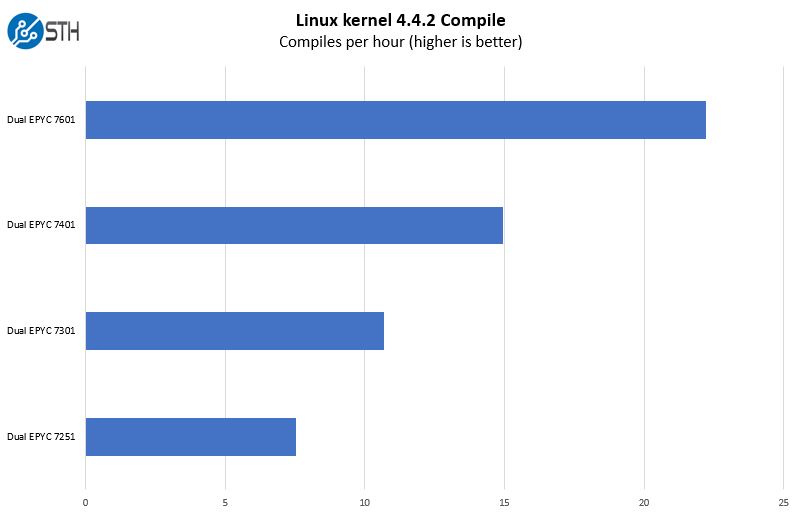
This chart shows both the top-end SKU option at over $4000 per chip as well as the lowest end solution at under $500 per chip. AMD has a broad range of performance they are covering with the different SKUs.
c-ray 1.1 Performance
We have been using c-ray for our performance testing for years now. It is a ray tracing benchmark that is extremely popular to show differences in processors under multi-threaded workloads. We are going to use our new Linux-Bench2 8K render to show differences.
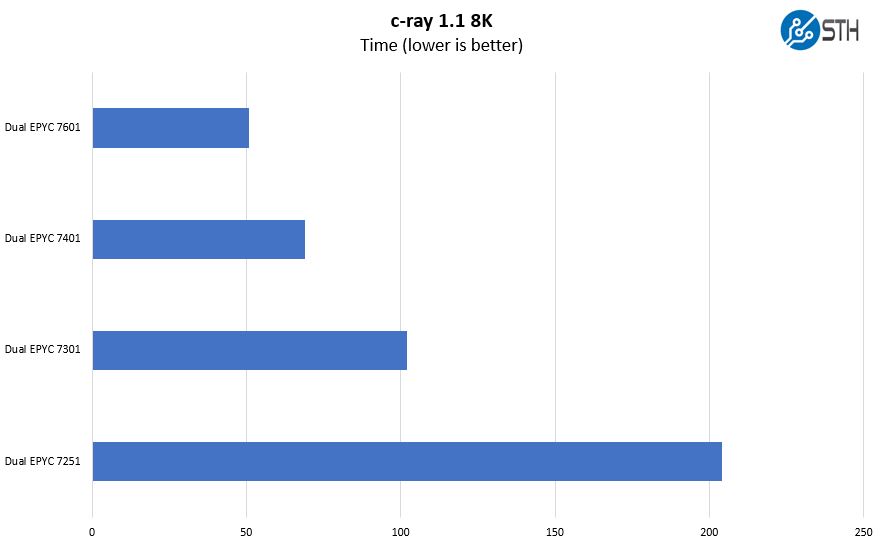
If you read our Dual AMD EPYC 7251 Linux Benchmarks Least Expensive 2P EPYC review, this chart illustrates why we generally advise getting at least 16 core AMD EPYC parts in dual socket systems.
7-zip Compression Performance
7-zip is a widely used compression/ decompression program that works cross-platform. We started using the program during our early days with Windows testing. It is now part of Linux-Bench.
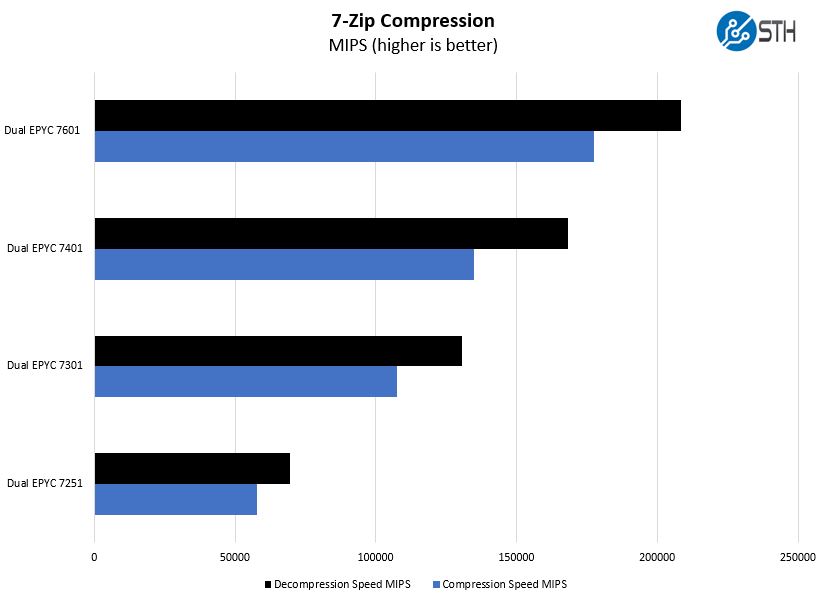
Here performance across the board is strong. AMD architectures get more decompression MIPS in this test than compression MIPS while Intel Xeon Scalable (Skylake-SP) generally shows the opposite pattern.
OpenSSL Performance
OpenSSL is widely used to secure communications between servers. This is an important protocol in many server stacks. We first look at our sign tests:
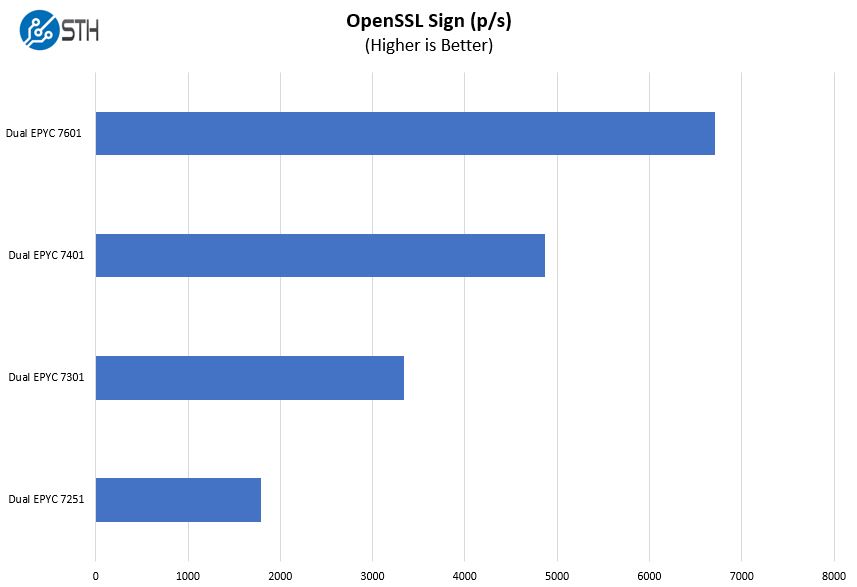
Here are the verify results:
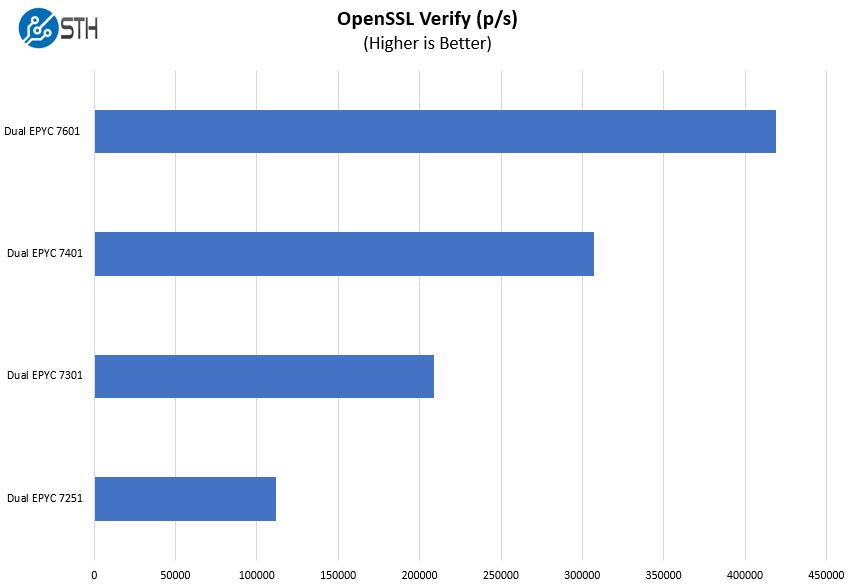
Again, looking at a total cost for the system, we think that starting at 16 or 24 cores for a dual AMD EPYC server like this is the best course of action.
Chess Benchmarking
Chess is an interesting use case since it has almost unlimited complexity. Over the years, we have received a number of requests to bring back chess benchmarking. We have been profiling systems and are ready to start sharing results:
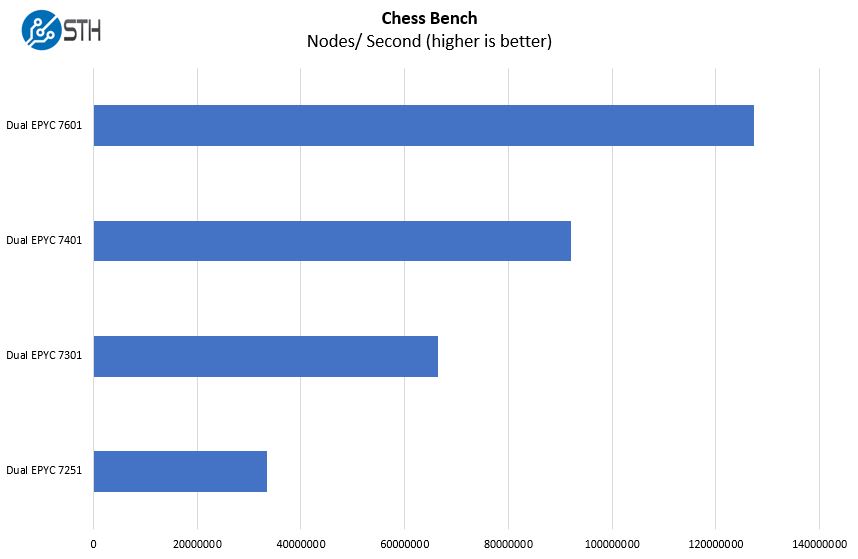
AMD offers one SKU, the AMD EPYC 7351 between the EPYC 7301 and EPYC 7401 but there are three SKUs between the EPYC 7401 and EPYC 7601. These three SKUs are the EPYC 7451, EPYC 7501 and EPYC 7551. That gives a lot of customization options beyond what we are showing here, but they generally follow the trends we have shown.
Supermicro AS-4023S-TRT Power Consumption
Although the dual AMD EPYC designs can offer a lot of performance, they do so while surprisingly sipping power. We swapped the system into rackmount mode and put it in our data center using 208V 30A Schneider Electric APC PDUs. Using the dual AMD EPYC 7601 chips we saw solid figures:
- Idle: 112W
- STH 70% Load: 381W
- 100% Load AVX2 (GROMACS): 478W
- Maximum: 491W
That was a solid showing and lower than we would expect competitive Intel parts to be (such as the Intel Xeon Gold 6152.) Despite this power consumption, we were able to get this system to over 60dba which is too loud to be placed in office workspace, but it is acceptable for most server cabinets in branch offices.
Note these results were taken using a 208V Schneider Electric / APC PDU at 17.8C and 71% RH. Our testing window shown here had a +/- 0.3C and +/- 2% RH variance. The figures are certainly more than the Intel Xeon Silver line, but with that extra power consumption, AMD is delivering a more expandable platform and more performance.
Final Words
If you are looking for a larger size 4U or tower AMD EPYC 7000 series dual socket server this is one of the only options out there. For AMD, the Supermicro AS-4023S-TRT is an important machine. Virtually the entire AMD EPYC 7000 ecosystem is focused on the rackmount form factor. This is one of the only options for those looking at a pedestal/ tower form factor. One may look at pictures of the system and think that this is a workstation chassis. Despite the use of -SQ “Super Quiet” power supplies, it is too loud to use as a workstation in its current form. We think that there is an opportunity for Supermicro to change the fan curves and make this into a viable workstation platform or workgroup server that can be placed under a desk.
As a pure server, the Supermicro AS-4023S-TRT server is an excellent option. Its versatility means that the server can be deployed into a range of environments. For those building branch office, AMD EPYC 7000 series appliances the system has more RAM capacity than Intel solutions, more cores than Intel solutions, and the versatility to deploy into tower or rackmount orientations.
Here is a link to the product page.




Great review STH. Really in-depth. This looks like a great machine but I wish it had the extra NVMe hot swap like you mentioned and support for 3 GPUs. I don’t really think 10g networking is getting adopted much in the DC but in offices I’m seeing it more often these days because you don’t have to redo wiring
Two AMD EPYC cpus can support 4 TB of RAM, which is incredibly powerful and unique, what happen to that. Is this system limited to only 2 TB of RAM.. even though it has a dual socket/cpu configuration..?
Only 8 dimms per cpu so this only supports 1TB per CPU not 2TB as if it had 16 dimms per cpu.
Hey! Nice review! Small typo:
Power is provided via redundant 1280W 80Plus Platinum-level CPUs which provides both power efficiency as well as redundancy.
I don’t think the CPU’s are powered by CPU’s ;)
Thanks @ Brennen Smith. Fixed.
Key Features
• Cloud Computing
• Data Center
• General purpose, SMB, Web Hosting
They forgot Gaming Desktop.
Churchill they also forgot NAS and router. SM’s version of every box is good for everything let’s pile on.
Interesting fact is that dual 7301 is at least in linux compile benchmark on the level of recently tested/reviewed X11SDV with D-2183. So man really need to decide if he needs 2 TB of RAM and if not, then they are smaller less noisy alternatives. Also it looks like for this box putting there 7301 is not the best option and if man sattles on dual CPU box, then the CPUs employed should be power-full enough not to be over played by single-CPU alternatives…
I wish it had storage options like Dell Poweredge T640. Even 1U/2Us have more storage these days.